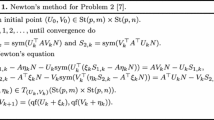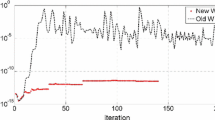Abstract
This paper focuses on algorithms for the truncated Takagi factorization of complex symmetric matrices. The problem is formulated as a Riemannian optimization problem on a complex Stiefel manifold and then is converted into a real Riemannian optimization problem on the intersection of the real Stiefel manifold and the quasi-symplectic set. The steepest descent, the Riemannian nonmonotone conjugate gradient, Newton, and hybrid methods are used for solving the problem and they are compared in their performance for the optimization task. Numerical experiments are provided to illustrate the efficiency of the proposed method.






Similar content being viewed by others
Data availability
The data and code that support the findings of this study are available from the first author upon reasonable request.
References
Horn, R.A., Johnson, C.R.: Matrix Analysis. Cambridge University Press, Cambridge, UK (1990)
Bunse-Gerstner, A., Gragg, W.B.: Singular value decompositions of complex symmetric matrices. J. Comput. Appl. Math. 21, 41–54 (1988)
Pommerenke, C.: Univalent functions. Vandenhoeck & Ruprecht, Göttingen (1975)
Trefethen, L.: Near circularity of the error curve in complex Chebyshev approximation. J. Approx. Theory 31, 344–367 (1981)
Comon, P.: Independent component analysis, a new concept? Signal Process. 36, 287–314 (1994)
Bain, A.D.: Chemical exchange in NMR. Prog. Nucl. Magn. Reson. Spectrosc. 43, 63–103 (2003)
Xu, W., Qiao, S.: A divide-and-conquer method for the Takagi factorization. SIAM J. Matrix Anal. Appl. 30, 142–153 (2008)
Sato, H., Iwai, T.: A Riemannian optimization approach to the matrix singular value decomposition. SIAM J. Optim. 23, 188–212 (2013)
Stao, H., Iwai, T.: A complex singular value decomposition algorithm based on the Riemannian Newton method. In: 52nd IEEE Conference on Decision and Control. 2972–2978 (2013)
Sato H.: Riemannian conjugate gradient method for complex singular value decomposition problem, In: 53rd IEEE Conference on Decision and Control. 5849–5854 (2014)
Bendokat, T., Zimmermann, R.: The real symplectic Stiefel and Grassmann manifolds: metrices, geodesics and applications. ar**v preprint ar**v: 2018.12447 (2021)
Gao, B., Son, N.T., Absil, P.-A., Stykel, T.: Riemannian optimization on the Symplectic Stiefel manifold. SIAM J. Optim. 31, 1546–1575 (2021)
Bunse-Gerstner, A.: Matrix factorizations for symplectic QR-like methods. Linear Algebra Appl. 83, 49–77 (1986)
Absil, P., Mahony, R., Sepulchre, R.: Optimization algorithms on matrix manifolds, Princeton University Press (2008)
Grippo, L., Lampariello, F., Lucidi, S.: A nonmonotone line search technique for Newton’s method. SIAM J. Numer. Anal. 23, 707–716 (1986)
Dai, Y.: A nonmonotone conjugate gradient algorithm for unconstrained optimization. J. Syst. Sci. Complex. 15, 139–145 (2002)
Zhu, X.: A Riemannian conjugate gradient method for optimization on the Stiefel manifold. Comput. Optim. Appl. 67, 73–110 (2017)
Li, J., Li, W., Vong, S., Luo, Q., **ao, M.: A Riemannian optimization approach for solving the generalized eigenvalue problem for nonsquare matrix pencils. J. Sci. Comput. 82, 1–43 (2020)
Sato, H., Iwai, T.: A new, globally convergent Riemannian conjugate gradient method. Optim. 64, 1011–1013 (2015)
Horn, R.A., Johnson, C.R.: Topics in matrix analysis. Cambridge University Press, Cambridge, MA (1991)
Wen, Z., Yin, W.: A feasible method for optimization with orthogonality constraints. Math. Program. 142, 397–434 (2013)
Suliman, A.: Hybrid methods for approximating Hankel matrix. Numer. Algor. 32, 57–66 (2003)
Acknowledgements
The authors thank the anonymous referees for their helpful comments and valuable suggestions.
Funding
**ao Shan Chen is supported by the National Science Foundation of China under Grant numbers 11771159, as well as the Guangdong Provincial Natural Science Foundation under project number 2022A1515011123.
Author information
Authors and Affiliations
Contributions
Both authors wrote the main manuscript text. Ling Chang Kong performed the experiment. **ao Shan Chen contributed to the conception of the study and helped to improve this manuscript with constructive suggestions. Both authors reviewed the manuscript.
Corresponding author
Ethics declarations
Ethical approval
Not applicable
Conflict of interest
The authors declare no competing interests.
Additional information
Publisher's Note
Springer Nature remains neutral with regard to jurisdictional claims in published maps and institutional affiliations.
Rights and permissions
Springer Nature or its licensor (e.g. a society or other partner) holds exclusive rights to this article under a publishing agreement with the author(s) or other rightsholder(s); author self-archiving of the accepted manuscript version of this article is solely governed by the terms of such publishing agreement and applicable law.
About this article
Cite this article
Kong, L.C., Chen, X.S. Riemannian optimization methods for the truncated Takagi factorization. Numer Algor (2023). https://doi.org/10.1007/s11075-023-01701-y
Received:
Accepted:
Published:
DOI: https://doi.org/10.1007/s11075-023-01701-y




